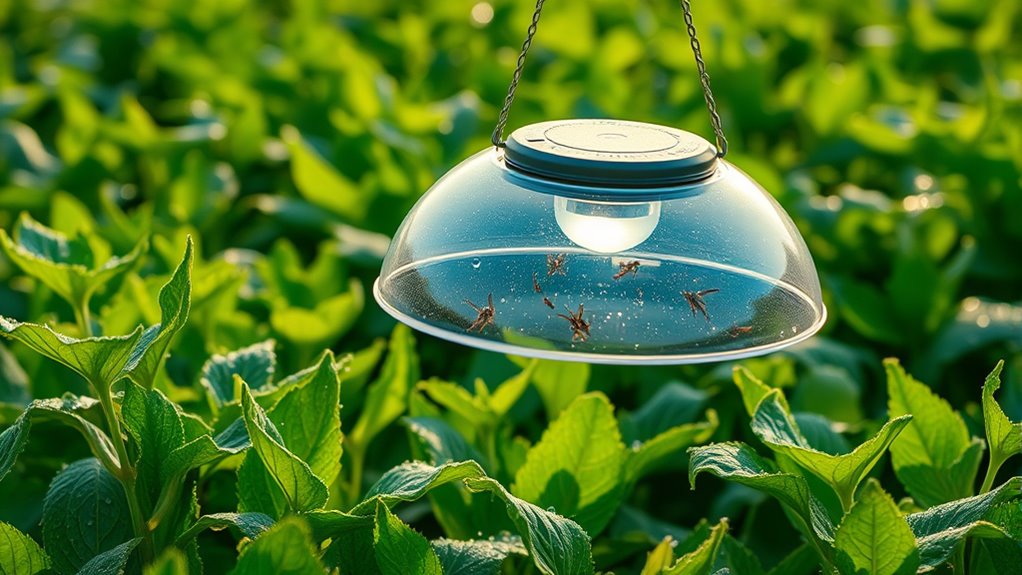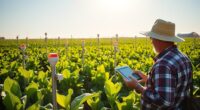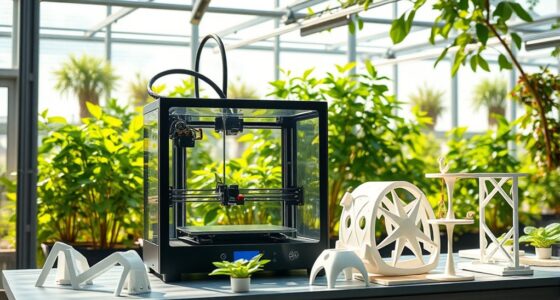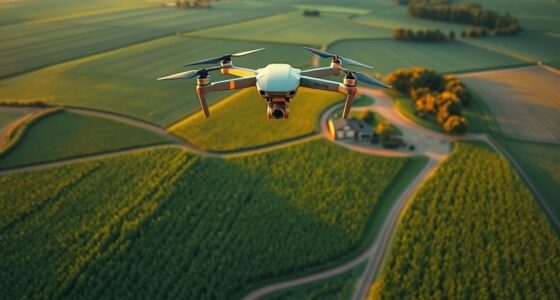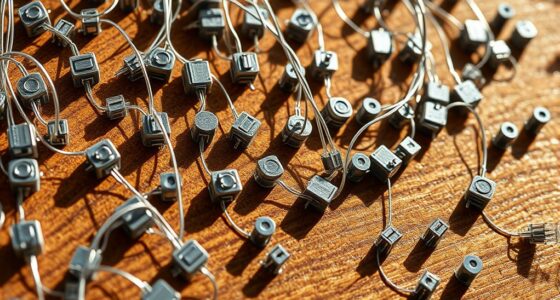IPM technology uses monitoring and traps to help you detect pests early and target them efficiently. Sticky traps and baited devices capture flying insects, giving you real-time data to guide your decisions. This approach supports biological controls and minimizes chemical use, promoting a healthier environment. Monitoring allows you to act only when necessary, reducing pest resistance and ecological impact. Keep exploring to discover how these tools can optimize your pest management practices even further.
Key Takeaways
- Monitoring traps enable early pest detection and real-time data collection for targeted pest management.
- Sticky and baited traps help identify pest presence and pest levels accurately.
- Trap data guides biological control efforts by indicating when natural enemies should be introduced.
- Monitoring informs chemical treatment decisions, minimizing chemical use and resistance development.
- Integrating traps with eco-friendly methods enhances sustainable and effective IPM practices.
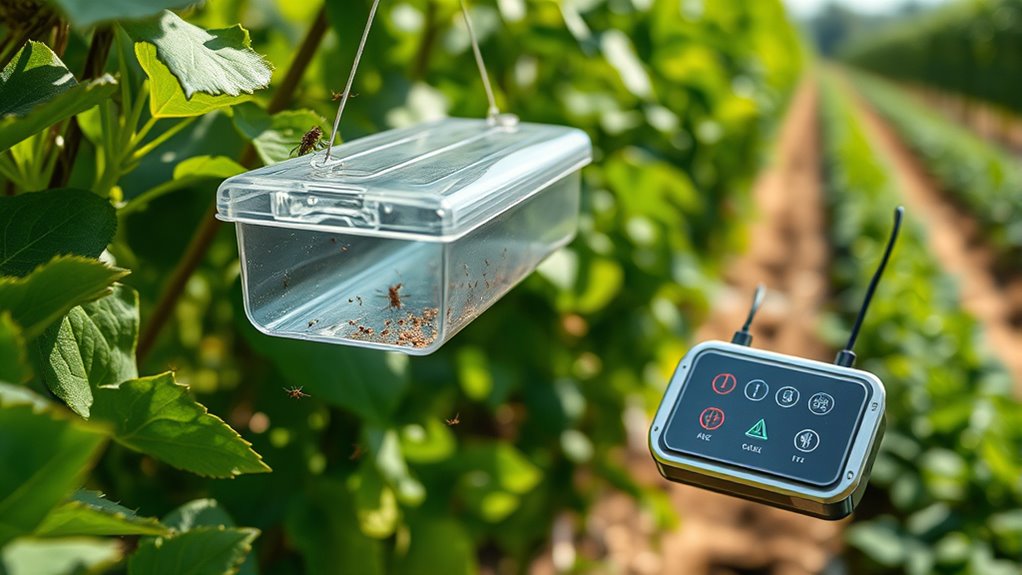
Integrated Pest Management (IPM) technology transforms how you control pests by combining eco-friendly methods with advanced tools. One of the most effective strategies involves monitoring pests closely and using traps to detect their presence early. This approach allows you to make targeted decisions, reducing the need for broad-spectrum chemical use. When it comes to monitoring, traps are your first line of defense—they help you identify pest populations before they reach damaging levels. Sticky traps catch flying insects like whiteflies or aphids, giving you visual confirmation of pest activity. Baited traps, on the other hand, lure specific pests, making it easier to assess the extent of an infestation. By regularly inspecting these traps, you gain real-time data, enabling you to act swiftly and precisely. Incorporating monitoring techniques enhances the accuracy and effectiveness of your pest control efforts.
Monitoring also plays a critical role in implementing biological control strategies effectively. For example, if you notice an increase in pest numbers on your traps, you can introduce natural enemies like ladybugs, parasitic wasps, or predatory mites. These biological controls work synergistically with traps, providing a sustainable, chemical-free solution that keeps pest populations in check. Using biological control not only reduces reliance on chemicals but also encourages a balanced ecosystem where beneficial insects thrive. This integrated approach minimizes environmental impacts and safeguards your crops or property.
In addition to biological controls, traps can help you evaluate the need for chemical alternatives. When pest numbers surpass a certain threshold, you might consider targeted, low-impact chemical treatments. The data collected from traps helps you decide when and where to apply these chemicals, ensuring you don’t overuse them. This precision application reduces chemical exposure to non-target species and decreases the chance of pests developing resistance. It’s all about making smarter, more sustainable choices based on accurate pest monitoring.
Frequently Asked Questions
How Accurate Are IPM Monitoring Tools?
IPM monitoring tools are quite accurate when properly maintained. You should regularly calibrate your traps to verify data accuracy, which helps in correctly evaluating pest populations. Proper trap placement and routine checks also improve the reliability of results. When you follow these best practices, you’ll get precise information, allowing you to make informed decisions about pest management. Consistent calibration and careful data collection are key to maximizing trap effectiveness.
Can Traps Be Reused After Catching Pests?
Yes, you can reuse traps after catching pests if they have good trap durability and are in decent condition. Always follow reuse guidelines to guarantee effectiveness and avoid pest spread. Clean traps thoroughly, remove any residues, and check for damage before reusing. If traps are worn out or damaged, it’s better to replace them to maintain ideal pest monitoring and control. Proper care ensures reliable results and cost savings.
What Is the Cost of Implementing IPM Traps?
Think of IPM traps as your secret weapon against pests. They cost vary depending on trap type and placement; you might spend $10 to $50 per trap. Proper trap placement and pest identification are key to effective monitoring. Investing in these traps saves you money long-term by reducing pesticide use and preventing damage. Consider your pest problem’s severity to determine the number and type of traps that fit your budget.
Are There Eco-Friendly Trap Options Available?
Yes, eco-friendly alternatives like biodegradable traps are available for pest monitoring. These traps use sustainable materials that break down naturally, reducing environmental impact. You can choose options made from biodegradable plastics or paper-based materials, which are safe for wildlife and your surroundings. Using these eco-friendly traps helps you manage pests effectively while supporting environmental conservation efforts. They’re a responsible choice for sustainable pest control.
How Often Should Traps Be Checked for Effectiveness?
You should check your traps at least once a week to guarantee they’re effective. Studies show that more frequent inspections can reduce pest populations by up to 50%. Proper trap placement is essential; place them where pests are most active. Regular inspection frequency helps you catch infestations early and adjust your IPM strategy promptly. Don’t wait too long—consistent checking keeps your pest management system working efficiently.
Conclusion
By using IPM technology like monitoring and traps, you can effectively manage pests while reducing chemical use. Did you know that farms implementing IPM see up to a 50% decrease in pesticide applications? This not only benefits your crops but also protects the environment. Embracing these sustainable methods helps you stay ahead of pest problems and promotes healthier yields. So, consider IPM as your go-to strategy for smarter, eco-friendly pest management.
